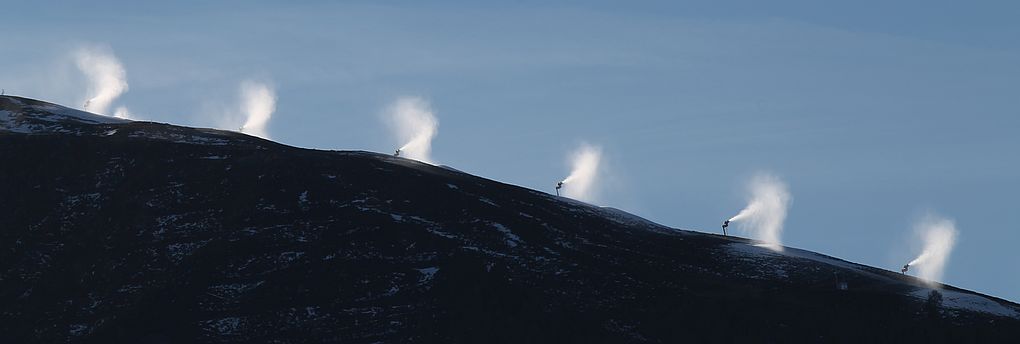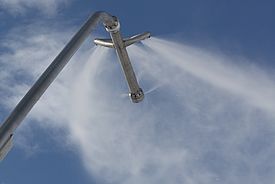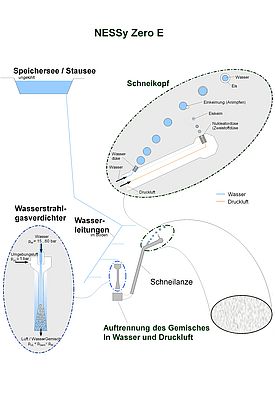
Artificial snow
Many winter sports resorts depend on snowmaking for their livelihood. We are working on new techniques that consume less energy and water, and investigating the ecological consequences of snowmaking.
Natural snow is formed by water vapour bypassing the liquid phase and depositing directly onto seed crystals. Artificial snow, in contrast, is produced by freezing liquid water directly. In practice it is made by spraying tiny water droplets into the cold air. As they fall to the ground, the droplets freeze to form small beads of ice. These freeze outside first, then inside. For this reason artificial snow is denser and harder than natural snow and is more suitable for winter sports pistes, which need to be compacted by grooming in order to withstand the rigours of sports use.
Snowmaking equipment
The principal type of equipment used to make snow nowadays sprays water through nozzles. As it is sprayed into the air, the water forms droplets. At the same time, a mixture of compressed air and water is sprayed through smaller nozzles. These microscopic droplets immediately freeze to form tiny grains of ice, which serve as freezing nuclei for the larger water droplets (see also Fig. 3). Creating these nuclei allows snow to be produced at a temperature just below 0° C (water would not normally freeze until it cools below -7° C). The further development of snowmaking techniques can harness significant energy-saving potential. In collaboration with industrial partners and the University of Applied Sciences of North West Switzerland we modelled the entire freezing process that occurs during artificial snowmaking, and tested the models in field and laboratory experiments. This work culminated in the development of a snow lance called NESSy (Fig. 1), which can reduce the amount of energy consumed by snowmaking by as much as 80%.
A follow-on project gave rise to the snow gun NESSy ZeroE (Fig. 2), which obtains all the energy it requires from the environment. Drawing water from a reservoir situated higher up the mountain naturally raises air pressure without the need for compressors, thanks to gravitational potential energy. The operating principle (illustrated in Fig. 3) eliminates the need for both electrical power and the customary compressed air infrastructure. NESSy ZeroE is already making snow in the resort of Melchsee-Frutt.
Ecological impact
Artificial snowmaking affects the environment in a variety of ways. The additional snow can, for example, protect the soil and vegetation from the damage that can be caused by snowcats or ground frost. Our investigations also show that slopes prepared with artificial snow become bare up to 4 weeks later than natural pistes. The shorter vegetation period and greater water quantity exert an influence on plant composition. In addition, artificial snow increases the nutrient input because the water it contains originates not directly from the atmosphere, but mostly from reservoirs. The elevated nutrient input and abbreviated vegetation period could reduce the variety of species on ski runs in the longer term.
Consumption of resources
The amount of energy consumed by artificial snowmaking varies widely, depending on the equipment. While NESSy ZeroE operates without any additional energy, large snow cannons can consume as much as 20 kW an hour. Producing snow with these propeller-type machines in high temperatures consumes even more energy. Pumping water up the mountain from the valley consumes a lot of energy as well. For this reason many ski resorts collect and store water in reservoirs during the summer. Although the amount of energy consumed by some snowmaking equipment has been reduced in recent years, water consumption remains very high. One-fifth of the water consumed in the Davos region, for example, is sprayed into the air to produce artificial snow. Since natural watercourses generally carry less water in the winter, compliance with the minimum water levels prescribed by law is imperative from an ecological perspective. This calls for ecologically compatible solutions capable of accommodating the diverse demands of agricultural irrigation, power generation, drinking water and snowmaking. Our studies show that 15 to 40% of the water consumed by snowmaking is attributable to evaporation and wind losses. We are therefore investigating the relationship between water loss, weather conditions, and snow gun settings. We expect to be able to improve the efficiency of snowmaking with the aid of the data we are collecting.


